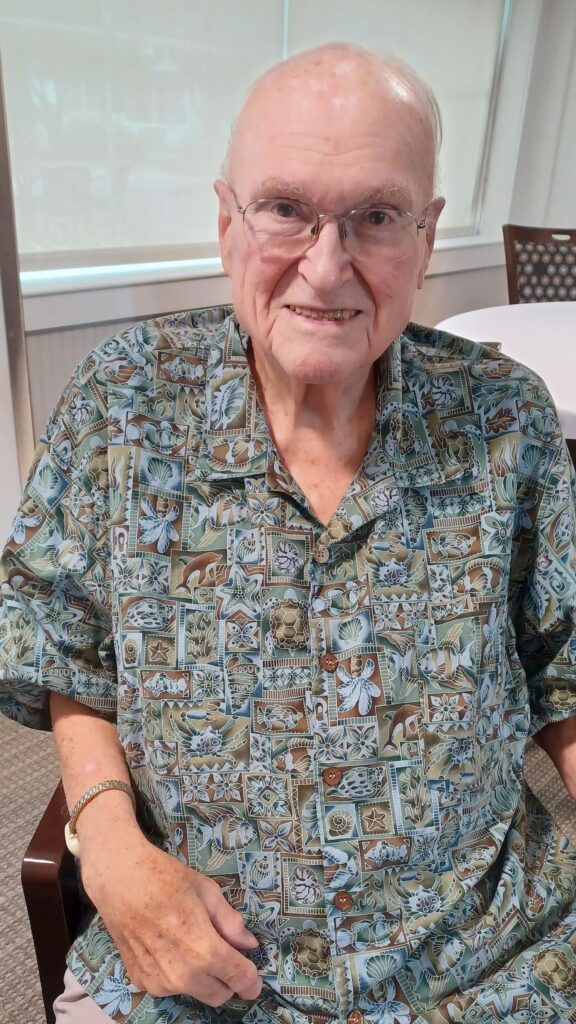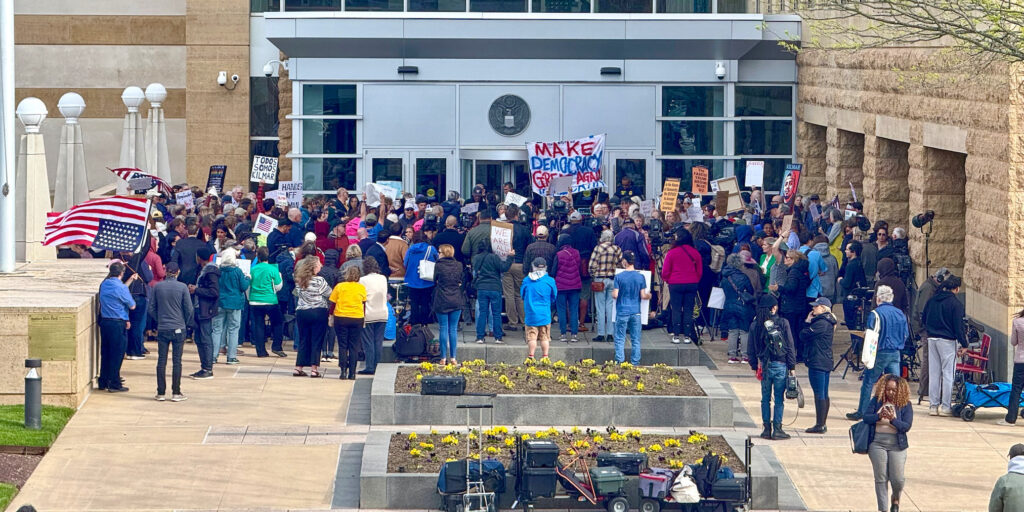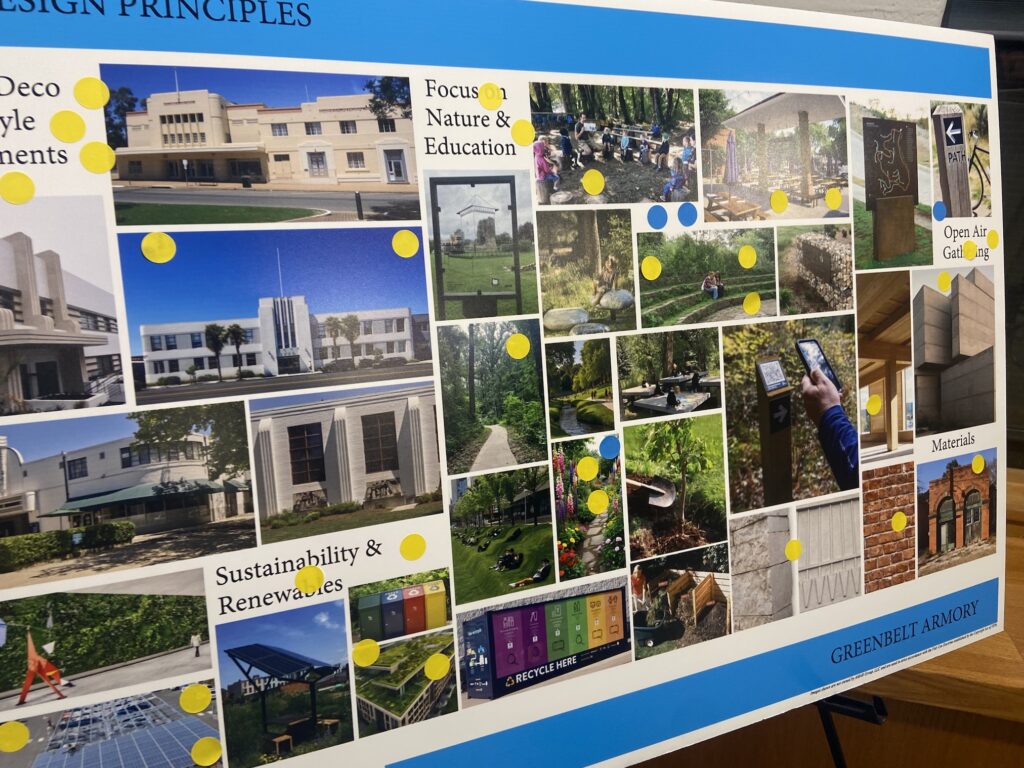On December 8, 1962, then-Greenbelt Mayor Francis White told the audience at the 25th anniversary celebration of the Greenbelt News Review that he had to leave the party to fly to Chicago to interview James K. Giese, acting city manager of Western Springs, Ill. Accompanied by then-councilmember Dave Champion, White conducted the interview and hired Giese, subject to council approval, to become Greenbelt’s fourth city manager.
On the following Monday, December 10, Giese was unanimously appointed city manager, succeeding Charles T. McDonald, who had retired. Giese arrived in Greenbelt on Saturday, December 15. He attended a reception in his honor on Sunday, December 16, and his first council meeting on Monday, December 17. With seeming imperturbability, he served 15 elected city councils over a 29-year period, according to the Greenbelt News Review, May 16, 1991.
When the 32-year-old Giese became city manager in 1962, Greenbelt was fighting numerous development battles. Chief among them was the county’s Master Plan for College Park, Greenbelt and vicinity that called for zoning changes with large-scale multifamily apartments, commercial development and a four-lane highway running through the core city.
During a recent interview with Giese, he recalled that in the early 1960s, the county’s planning board met in sessions closed to the public; only the planners and developers participated in discussions. Greenbelt’s mayor Richard Pilski was friends with the chairman of the planning board who resided in Berwyn Heights. He invited Pilski and Giese to sit in on a meeting. Soon after, other municipal leaders lobbied for open meetings with public participation. Pilski and Giese became trail blazers.
“When I arrived, the majority of land within the city was undeveloped,” Giese wrote in a recent document tracing Greenbelt’s development history. “When I retired, little land remained to be privately developed. While my work primarily involved working with developer representatives such as attorneys, planners, architects, engineers and project managers, I also got to meet with and know slightly the men (no women) who developed the vacant land in Greenbelt,” Giese reminisced.
“What impressed me about the developers was that they were involved in major construction projects while still, for the most part, fairly young, some just a few years older or younger than I was. I considered myself to be somewhat successful, being paid a salary of $10,000 to manage a city with a budget just over $300,000. Yet these developers were earning who knows what kind of money while undertaking projects costing in the hundreds of millions of dollars,” he stated.
With rapid construction occurring in the suburban areas, developers envisioned Greenbelt as a city growing to 50,000 residents. In 1964, 1,000 apartments were built in Springhill Lake. By 1967, Springhill Lake expanded to 2,668 units, becoming one of the largest multifamily developments on the East Coast.
Other new developments in the 60s included Beltway Plaza, the apartment complexes Lakeside North, Charlestowne North and University Square, as well as nearby Westchester Park. Lakeside and Boxwood Village added single family homes. Between 1960 and 1969 Greenbelt’s population more than doubled from 7,479 to 18,199 and the city’s budget went from $286,797 to $985,300.
The 1960s also heralded the development of the Goddard Space Flight Center. Rapid road construction included the Baltimore-Washington Parkway, Interstate 95 and the Beltway that essentially divided Greenbelt into three diverse sections. The Metro Green Line construction was underway but lagged behind its scheduled completion date of 1979, mired in disagreements over funding, routes and alignments.
In the 1970s controversies swirled over the proposed development of a three-school complex on Northway extended, what is now woodlands. This was followed by battles with the school board over the selection of a site for a new high school. Other storms raged over the construction of a sewage treatment plant during a seven-year state moratorium that was delaying the proposed development of Greenbriar condominiums, Glen Oaks apartments and Windsor Green townhomes.
Greenbelt had its own development projects that included the addition of the Aquatic & Fitness Center and the Art Deco-styled police station at Crescent and Ridge Roads. Giese is most proud of the development of Green Ridge House for senior citizens, although he said the construction caused him many headaches. It was a joint venture with the city, the state and the federal government providing funding. Seeking to reduce cost, the city eliminated garbage disposals from the plan. While this decision did not cover all of the cost overruns, no agency wanted to pay for the removal of tons of cow manure from the site. Eventually, the state agreed to pay, Giese smiled.
He is also proud of furthering the career of Steve Parker, the architect for Green Ridge House. It was Parker’s first real design project, he remarked. Parker has gone on to design many other public facilities, including Greenbelt’s police station.
At a meeting held with councilmembers prior to his retirement in 1991, Giese commented that “some developers thought the original community should be bulldozed for better quality … it has been my job to do what council wants.”
Giese has been recognized throughout the state of Maryland and the metro area for his professionalism, the degree to which he earned the respect of his staff as well as city councilmembers with differing personalities. The council praised Giese for the research notes he provided that shaped their discussions of agenda items. Former staff members said he inspired them to work with a high degree of professionalism.
Post-retirement Years
A confirmed bachelor during his years with the city, Giese found romance after he retired. He and Bernina McGee (Bernie) got to know each other better through their volunteer work for the News Review. They married on March 21, 1998. “In all my years at the Greenbelt Community Church there was never a more joyous wedding than when Jim and Bernie McGee wed,” commented Dan Hamlin, former minister. Giese enjoyed his new expanded family with two stepdaughters and their grandchildren.
In 2010 Giese was named Greenbelt’s Outstanding Citizen. He was honored for his contributions to the community since his retirement. His colleagues on the News Review staff described him as indispensable for his election analyses, knowledge of city policy issues and familiarity with city and county budgets. He also wrote numerous stories on Greenbelt’s history.
After receiving the honor of being Greenbelt’s Outstanding Citizen, he wrote a Letter to the Editor and noted that although he moved out of Greenbelt after 40 years of living on Maplewood Court, “we shall continue to be part of Greenbelt as much as possible and our hearts shall always be with you.” He and Bernie moved to the Collington Episcopal Lifecare Community in Mitchellville in 2009. Sadly, Bernie died on June 19, 2014. At age 93, Jim now resides in the assisted living component of Collington.
Tributes
“I learned early on in my years with the city that managing the City of Greenbelt was Jim’s life. He worked incredible hours, often late into the evenings, taking work home, doing writing to be completed the following day. He was an incredibly good writer, knowledgeable in all aspects of the city.
He had no family of his own, yet he seemed to understand family concerns. Jim worked tirelessly to increase benefits for all employees ‒ sick and annual leave, health benefits, retirement savings, etc. When employees had problems, every effort was made to give them assistance. The City of Greenbelt was a family-friendly organization long before that became common in the workforce.”
Barbara Havekost, former Director of Human Resources, City of Greenbelt
“Jim Giese changed my life. When I left military service in 1970, I was anxious to continue with the law enforcement career that I began while a member of the Air Force. My good fortune led me to Greenbelt…. I applied to many police departments…. Mr. Giese took a chance on me by offering gainful employment. Little did I know that I would spend over 46 years working for the city due directly to his mentorship and guidance. I will be forever grateful that he chose me to lead the Police Department in 1986, a position I cherished and still miss.
I found Mr. Giese to be the epitome of the type of boss everyone would like to have. Always kind, forever caring, stoic under pressure. In time he became more than the city manager to me, he was a surrogate father. I treasure the time we spent together. I love the guy.”
Jim Craze, former Greenbelt Police Chief
“I was a relatively new planner when Jim took a chance and hired me as the city’s first Planning and Development Coordinator. Little did I know then that he would become one of the most influential figures in my life. In fact, I can say that other than my father, my mother and my husband, Jim was the most influential figure in my life. He immediately vested in me responsibility for major projects. He gave me confidence by showing confidence to me. He taught me to trust in the skills, knowledge and ability of others, which would ultimately allow me to take the position of Director of the Department of Planning and Community Development with a staff of 13. I quickly learned that no matter how hard or long I would work, he would always work harder and longer than anybody else in city employ. And most importantly, he taught me that working in public service is a high and honorable calling, being tasked to serve others. Those were some of the lessons he taught me. I will forever be thankful for the opportunity to serve the citizens of Greenbelt, and he will always have a special place in my heart.”
Celia Craze, former Director of Community Planning and Development
“Jim is an absolute treasure… His quiet wisdom was respected by everyone. Jim has a sparkling sense of humor that can catch one by surprise. When Jim spoke at my retirement service, he had me in tears and laughing uproariously at the same time.”
Dan Hamlin, former Minister, Greenbelt Community Church
“I joined the News Review in the spring of 1962. During my early years, I learned that staff had a high regard for the new city manager. I didn’t often get assigned to cover meetings as Al Skolnik (News Review president) had that beat. When I did get such an assignment, Al would have had reason to use a new unknown face. And I knew he could fix anything I had not understood.
After Al died in 1977, I recall going into Jim’s office with some questions I had about the council meeting I had covered. As it turned out, those questions were of minor importance and easily answered. Jim then asked to see my story and quickly found the questions I should have asked and explained those issues in detail. Handing back my story, he said “Now go home and rewrite it.”
Some time later Jim sent a letter to the News Review saying the newspaper needed help if it was to survive. The result was three outstanding people were recruited that included Diane Oberg, who still runs the business side of the paper and covers council meetings. When Jim retired, I invited him to join the newspaper.”
Mary Lou Williamson, Editor, Greenbelt News Review




